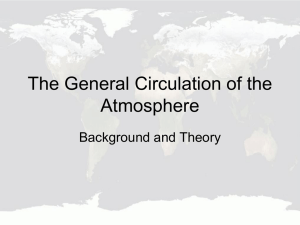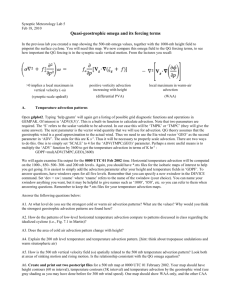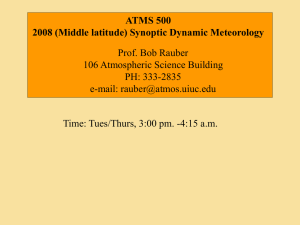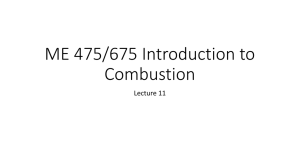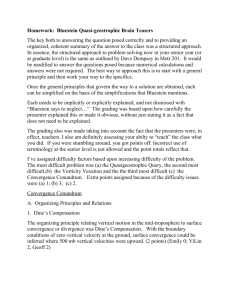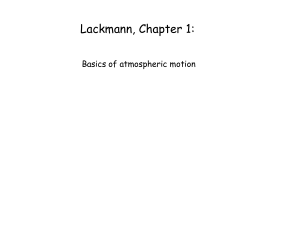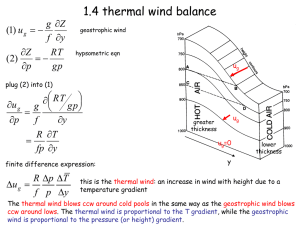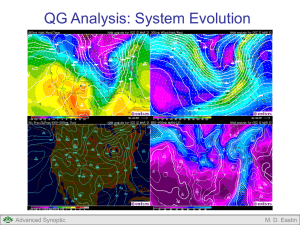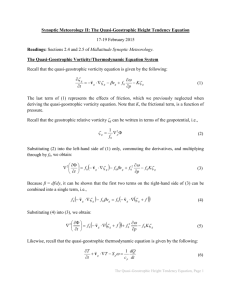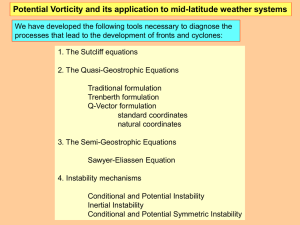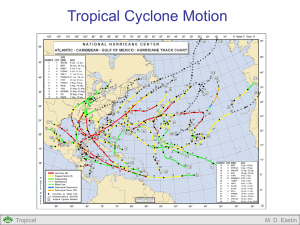09. Quasi-Geostrophic Theory 1
advertisement
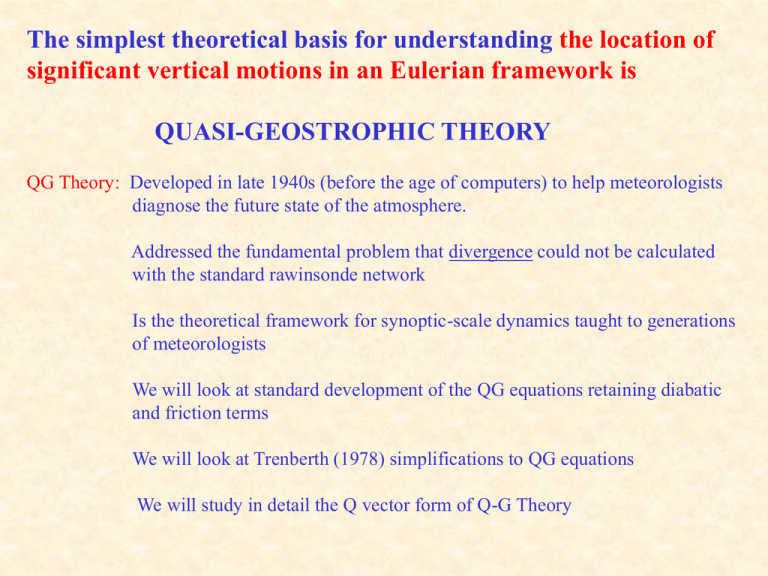
The simplest theoretical basis for understanding the location of significant vertical motions in an Eulerian framework is QUASI-GEOSTROPHIC THEORY QG Theory: Developed in late 1940s (before the age of computers) to help meteorologists diagnose the future state of the atmosphere. Addressed the fundamental problem that divergence could not be calculated with the standard rawinsonde network Is the theoretical framework for synoptic-scale dynamics taught to generations of meteorologists We will look at standard development of the QG equations retaining diabatic and friction terms We will look at Trenberth (1978) simplifications to QG equations We will study in detail the Q vector form of Q-G Theory We will first derive the vorticity equation du fv Fx dt x dv fu Fy dt y (1) (2) Expand total derivative u u u u u v fv Fx t x y P x Take v u v u u t x y x x y v v v v u v fu Fx t x y P y (2) (1) x y v u f v y x y v u f P x y v u u v u v Fx Fy f x y x y x y P y P x write relative vorticity v u x y as u v u v Fx Fy u f v f f t x y P x y P y P x x y The vorticity equation u v u v Fx Fy u f v f f t x y P x y P y P x x y Local rate of change of relative vorticity Horizontal advection of absolute vorticity on a pressure surface Divergence acting on Absolute vorticity (twirling skater effect) Tilting of vertically sheared flow Gradients in force Of friction Vertical advection of relative vorticity In English: Horizontal relative vorticity is increased at a point if 1) positive vorticity is advected to the point along the pressure surface, 2) or advected vertically to the point, 3) if air rotating about the point undergoes convergence (like a skater twirling up), 4) if vertically sheared wind is tilted into the horizontal due a gradient in vertical motion 5) if the force of friction varies in the horizontal. Next we will derive the “Quasi-Geostrophic” Vorticity Equation Start with vorticity equation u v u v Fx Fy u f v f f t x y P x y P y P x x y 1 2 3 4 5 6 1. 2. 3. 4. 5. 6. Based on scale analysis, we will ignore 3, 5, 6 and compared to f in 4 Assume relative vorticity in 1, 2 can be replaced by its geostrophic value g Replace divergence in 4 using continuity equation Assume that the velocity (u,v) in 2 can be replaced by its geostrophic value Assume Coriolis force varies linearly across mid-latitudes (f = f0 + y) Ignore y where f is not differentiated. g t 1 V g g f f 0 2 4 P Now derive the “Quasi-Geostrophic” Thermodynamic Equation Start with conservation of energy equation T T T T 1 dQ u v t x y p c p dt 1. 2. 1 2 Ignore 4, diabatic heating p T Use Hydrostatic equation 3 4 3. Move outside derivatives (P is held constant in derivatives in P coordinate system) 4. Multiple equation by p to replace T in 1 and 2. R p p R R TR V g t p p p p 5. Write TR/P as the specific volume , and then write , the static stability. p V g t p p 1 2 3 g t V g g f f 0 p Q-G vorticity equation V g t p p Q-G thermodynamic equation Now we will use the geostrophic wind relationships u g vg 1 to write g in terms of f 0 x vg u g 1 f 0 y and 1 1 1 2 2 1 2 2 2 g x y x f 0 x y f 0 y f 0 x y f 0 g 1 2 f0 1 2 1 V g 2 f f 0 f 0 t f0 p V g t P P Q-G vorticity equation Q-G thermodynamic equation We now have two equations in two unknowns, and We will solve these to find an equation for , the vertical motion in pressure coordinates, and for , the change of geopotential height with time. t Derive the Q-G omega equation (equation for vertical velocity in pressure coordinates) 1 2 1 2 V g f f0 f 0 t f0 p 1 V g t p P 2 1. 2. 3. 3. 4. 5. Assume is constant 1 2 Take f Eqn. 2 0 Take of Eq. 1. p Reverse order of differentiation on left side of equation Subtract: (1) – (2) Rearrange terms 1 2 2 f 02 2 f0 V g 2 p p f0 1 2 f V g p The QG omega equation can be derived including the friction term and the diabatic heating term. We will not do this here, but I will simply show the result. QG OMEGA EQUATION 1 2 2 f 02 2 f0 V g 2 p p f0 1 2 f V g p 1 dQ f0 R K g 2 p p CP dt BEFORE WE PROCEED TO TRY TO UNDERSTAND THIS EQUATIONS ANSWER THIS QUESTION: WHAT PHENOMENA OF IMPORTANCE ARE WE IMPROPERLY REPRESENTING IN THE DERIVATION OF THESE EQUATIONS? By assuming that the static stability, is constant p WE HAVE ELIMINATED A TERM RELATED TO FRONTS! We took x, y, and P derivatives assuming is constant Real Atmosphere () QG Atmosphere () Where does all the precipitation occur? Where does all the precipitation occur? ALONG FRONTS! By assuming that the static stability, is constant p WE HAVE ELIMINATED A TERM RELATED TO JETSTREAKS! We took x, y, and P derivatives assuming is constant – this implies that the vertical wind shear is constant, which can’t happen in a jetstreak environment To illustrate quasi-geostrophic vertical motion in a real system consider the cyclone below 700 mb height and rainwater field simulated by MM5 model Vertical motion calculated at 700 mb by MM5 Model Vertical motion attributed to terms in QG Omega equation Residual vertical motion (not attributable to QG forcing) Quasi-Geostrophic interpretation of the atmosphere: What the quasi-geostrophic solutions do: Quasi-Geostrophic Equations describe the broad scale ascent and descent in troughs and ridges and the propagation of these troughs and ridges. What the quasi-geostrophic solutions do not do: Quasi-Geostrophic Equations do not describe the mesoscale ascent and descent associated with ageostrophic circulation near fronts and within jetstreaks, nor the propagation of low and high pressure systems due to jetstreaks. (These are the motions are most responsible for significant weather) So what does the QG system equation tell us about the atmosphere and how should we use it to diagnose vertical motions? QG OMEGA EQUATION 1 2 2 f 02 2 f0 V g 2 p p f0 1 2 f V g p f0 R 2 1 dQ K g p p cP dt We are taking two derivatives of the vertical motion Let’s write as a Fourier series in x: an cosnx bn sin nx n 1 When we take two x derivatives of this series we get an n 2 cosnx bn n 2 sin nx 2 n 1 Therefore: First term is proportional to - Read the first term as “Rising motion” QG OMEGA EQUATION 1 2 2 f 02 2 f0 V g 2 p p f0 1 2 f V g P f0 R 2 1 dQ K g p p cP dt The second term is the vertical derivative of the absolute vorticity advection: Rising motion is proportional to “Differential Positive Vorticity Advection” 1 2 f0 V g p f0 f The geostrophic wind is strong at jetstream level and the height gradients are greatest. Vertical gradient in vorticity advection is strongest, on average, in middle troposphere (so absolute vorticity is typically Plotted on the 500 mb surface) The geostrophic wind is weak at low levels and the height gradients are weak. Relationship between Shear and curvature in the Jetstream Absolute vorticity and Abs. Vorticity Advection and Vertical Motion 1 2 f0 V g p f0 f QG OMEGA EQUATION 1 2 2 f 02 2 f0 V g 2 p p f0 1 2 f V g P f0 R 2 1 dQ K g p p cP dt is the depth, or thickness, of the layer between two pressure surfaces. This depth p is proportional to the mean temperature of the layer. We are taking two derivatives of the thickness advection, V g Let’s write A as a Fourier series in x: A p A an cosnx bn sin nx n 1 When we take two derivatives of this series we get A an n 2 cosnx bn n 2 sin nx 2 n 1 Multiply term by -1 twice to get in form consistent with temperature advection 2 Vg Vg p p 2 Read the term inside the parentheses as temperature advection However, it is the Laplacian of temperature advection we are interested in… Let’s rewrite this term: Vg Vg p p 2 If the gradient of temperature advection is constant, then the term is zero! THEREFORE: will be non-zero only in areas where the thermal advection pattern in non uniform Heterogeneity in warm advection on a pressure surface implies upward motion When air is ascending on an isentropic surface… …the projection of the wind on to a constant pressure surface appears as warm air flowing toward cold air (warm advection) But what if isentropic surface is moving northward at the same time? Warm advection involves both flow on the isentropic surface and movement of the surface Heterogeneity in cold advection on a pressure surface implies downward motion When air is descending on an isentropic surface… …the projection of the wind on to a constant pressure surface appears as cold air flowing toward warm air (cold advection) But what if isentropic surface is moving southward at the same time? Cold advection involves both flow on the isentropic surface and movement of the surface QG OMEGA EQUATION 1 2 2 f 02 2 f0 V g 2 p p f0 1 2 f V g p f0 R 2 1 dQ K g p p cP dt The vertical derivative of friction acting on the geostrophic vorticity Or more simply: The rate that friction decreases with height in the presence of cyclonic vorticity in the boundary layer QG OMEGA EQUATION 1 2 2 f 02 2 f0 V g 2 p p f0 1 2 f V g p f0 R 2 1 dQ K g p p cP dt 1 dQ cP dt Again: Two derivatives in x,y ……….proportional to negative With additional minus sign: Rising motion is proportional to the Laplacian of the diabatic heating rate (modulated by static stability) Sinking motion is proportional to the Laplacian of the diabatic cooling rate (modulated by static stability) Heterogeneity in the diabatic heating leads to rising motion From our earlier discussion of isentropic coordinates: 135 75K 0.65 K / mb p 115 mb p high static stability 250 large 335 650 p low static stability small 20K 0.06 K / m b p 315 m b From our earlier discussion of isentropic coordinates: d dt p For a given amount of diabatic heating, a parcel in a layer with high static stability Will have a smaller vertical displacement than a parcel in a layer with low static stability QG OMEGA EQUATION 1 2 2 f 02 2 f0 V g 2 p p f0 1 2 f V g p f0 R 2 1 dQ K g p p cP dt SUMMARY Broad scale (synoptic scale) rising motion in the atmosphere is proportional to: Differential positive vorticity advection Heterogeneity in the warm advection field The rate of decrease with height of friction in the presence of vortex Heterogeneity in the diabatic heating rate Broad scale (synoptic scale) desending motion in the atmosphere is proportional to: Differential negative vorticity advection Heterogeneity in the cold advection field The rate of decrease with height of friction in the presence of vortex Heterogeneity in the diabatic cooling rate Let’s compare the QG Omega Equation* with the Omega equation we derived a long time ago when we considered isentropic coordinates Recall for isentropic coordinates: dp dt p d p V p dt t Vertical Motion 1 2 2 f 02 2 f0 V g 2 p p f0 Temperature Advection 1 f 2 V g p Diabatic term R 2 1 dQ P C P dt *Note… I dropped friction term since we did not consider it in our discussion of isentropic coordinates Let’s compare the QG Omega Equation* with the Omega equation we derived a long time ago when we considered isentropic coordinates Recall for isentropic coordinates: dp dt p d p V p dt t Vertical Motion Must be Related! 1 2 2 f 02 2 f0 V g 2 p p f0 Temperature Advection 1 f 2 V g p Diabatic term R 2 1 dQ P C P dt *Note… I dropped friction term since we did not consider it in our discussion of isentropic coordinates 850 mb heights, temperature, winds TEMPERATURE ADVECTION TERM Warm advection Cold advection Pressure, winds and RH on 290 K isentropic surface TEMPERATURE ADVECTION TERM Ascent on isentropic surface Descent on isentropic surface p d p V p dt t 1 2 2 f 02 2 f0 V g 2 p p f0 1 2 f V g p So how are orange terms related??? R 2 1 dQ P C P dt Vertical displacement of isentrope = P t (Air must rise for isentrope to be displaced upward) Differential absolute vorticity advection measures the rate at which potential temperature surfaces rise or fall as ridges and troughs propagate along! 500 mb w 700 mb w

